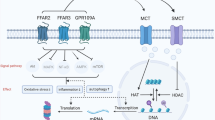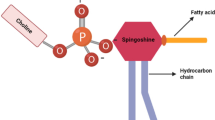Abstract
It is commonly accepted that brain phospholipids are highly enriched with long-chain polyunsaturated fatty acids (PUFAs). However, the evidence for this remains unclear. We used HPLC–MS to analyze the content and composition of phospholipids in rat brain and compared it to the heart, kidney, and liver. Phospholipids typically contain one PUFA, such as 18:2, 20:4, or 22:6, and one saturated fatty acid, such as 16:0 or 18:0. However, we found that brain phospholipids containing monounsaturated fatty acids in the place of PUFAs are highly elevated compared to phospholipids in the heart, kidney, and liver. The relative content of phospholipid containing PUFAs is ~ 60% in the brain, whereas it is over 90% in other tissues. The most abundant species of phosphatidylcholine (PC) is PC(16:0/18:1) in the brain, whereas PC(18:0/20:4) and PC(16:0/20:4) are predominated in other tissues. Moreover, several major species of plasmanyl and plasmenyl phosphatidylethanolamine are found to contain monounsaturated fatty acid in the brain only. Overall, our data clearly show that brain phospholipids are the least enriched with PUFAs of the four major organs, challenging the common belief that the brain is highly enriched with PUFAs.











Similar content being viewed by others
References
Farooqui AA, Horrocks LA, Farooqui T (2007) Modulation of inflammation in brain: a matter of fat. J Neurochem 101:577–599. https://doi.org/10.1111/j.1471-4159.2006.04371.x
Miller LR, Jorgensen MJ, Kaplan JR, Seeds MC, Rahbar E, Morgan TM, Welborn A, Chilton SM, Gillis J, Hester A, Rukstalis M, Sergeant S, Chilton FH (2016) Alterations in levels and ratios of n-3 and n-6 polyunsaturated fatty acids in the temporal cortex and liver of vervet monkeys from birth to early adulthood. Physiol Behav 156:71–78. https://doi.org/10.1016/j.physbeh.2015.12.009
Shepro D (2005) Microvascular Research: Biology and Pathology. Elsevier Science & Technology Books
Moore SA (2001) Polyunsaturated fatty acid synthesis and release by brain-derived cells in vitro. J Mol Neurosci 16:195–200; discussion 215-21. 10.1385/JMN:16:2-3:195
Srinivasan V, Pandi-Perumal SR, Cardinali DP, Poeggeler B, Hardeland R (2006) Melatonin in Alzheimer’s disease and other neurodegenerative disorders. Behav Brain Funct 2:15. https://doi.org/10.1186/1744-9081-2-15
Noseworthy MD, Bray TM (1998) Effect of oxidative stress on brain damage detected by MRI and in vivo 31P-NMR. Free Radic Biol Med 24:942–951
Friedman J (2011) Why is the nervous system vulnerable to oxidative stress? In: Gadoth N, Göbel HH (eds) Oxidative stress and free radical damage in neurology. Humana Press, Totowa, NJ, pp 19–27
Rink C, Khanna S (2011) Significance of brain tissue oxygenation and the arachidonic acid cascade in stroke. Antioxid Redox Signal 14:1889–1903. https://doi.org/10.1089/ars.2010.3474
van der Vusse GJ, Roemen TH, Prinzen FW, Coumans WA, Reneman RS (1982) Uptake and tissue content of fatty acids in dog myocardium under normoxic and ischemic conditions. Circ Res 50:538–546
Bazinet RP, Laye S (2014) Polyunsaturated fatty acids and their metabolites in brain function and disease. Nat Rev Neurosci 15:771–785. https://doi.org/10.1038/nrn3820
Angelini R, Vitale R, Patil VA, Cocco T, Ludwig B, Greenberg ML, Corcelli A (2012) Lipidomics of intact mitochondria by MALDI-TOF/MS. J Lipid Res 53:1417–1425. https://doi.org/10.1194/jlr.D026203
Ivanova PT, Cerda BA, Horn DM, Cohen JS, McLafferty FW, Brown HA (2001) Electrospray ionization mass spectrometry analysis of changes in phospholipids in RBL-2H3 mastocytoma cells during degranulation. Proc Natl Acad Sci USA 98:7152–7157. https://doi.org/10.1073/pnas.13119509898/13/7152
Milne S, Ivanova P, Forrester J, Alex Brown H (2006) Lipidomics: an analysis of cellular lipids by ESI-MS. Methods 39:92–103. https://doi.org/10.1016/j.ymeth.2006.05.014
Mitchell TW, Buffenstein R, Hulbert AJ (2007) Membrane phospholipid composition may contribute to exceptional longevity of the naked mole-rat (Heterocephalus glaber): a comparative study using shotgun lipidomics. Exp Gerontol 42:1053–1062. https://doi.org/10.1016/j.exger.2007.09.004
Abdullah L, Evans JE, Ferguson S, Mouzon B, Montague H, Reed J, Crynen G, Emmerich T, Crocker M, Pelot R, Mullan M, Crawford F (2014) Lipidomic analyses identify injury-specific phospholipid changes 3 mo after traumatic brain injury. FASEB J. https://doi.org/10.1096/fj.14-258228
Wang HY, Liu CB, Wu HW, Kuo JS (2010) Direct profiling of phospholipids and lysophospholipids in rat brain sections after ischemic stroke. Rapid Commun Mass Spectrom 24:2057–2064. https://doi.org/10.1002/rcm.4620
Cifkova E, Holcapek M, Lisa M (2013) Nontargeted lipidomic characterization of porcine organs using hydrophilic interaction liquid chromatography and off-line two-dimensional liquid chromatography-electrospray ionization mass spectrometry. Lipids 48:915–928. https://doi.org/10.1007/s11745-013-3820-4
Chen CT, Domenichiello AF, Trepanier MO, Liu Z, Masoodi M, Bazinet RP (2013) The low levels of eicosapentaenoic acid in rat brain phospholipids are maintained via multiple redundant mechanisms. J Lipid Res 54:2410–2422. https://doi.org/10.1194/jlr.M038505
Taha AY, Basselin M, Ramadan E, Modi HR, Rapoport SI, Cheon Y (2012) Altered lipid concentrations of liver, heart and plasma but not brain in HIV-1 transgenic rats. Prostaglandins Leukot Essent Fatty Acids 87:91–101. https://doi.org/10.1016/j.plefa.2012.07.006
Ulmann L, Mimouni V, Roux S, Porsolt R, Poisson JP (2001) Brain and hippocampus fatty acid composition in phospholipid classes of aged-relative cognitive deficit rats. Prostaglandins Leukot Essent Fatty Acids 64:189–195. https://doi.org/10.1054/plef.2001.0260
Szabo A, Mezes M, Romvari R, Febel H (2010) Allometric scaling of fatty acyl chains in fowl liver, lung and kidney, but not in brain phospholipids. Comp Biochem Physiol B: Biochem Mol Biol 155:301–308. https://doi.org/10.1016/j.cbpb.2009.11.018
O’Brien JS, Fillerup DL, Mead JF (1964) Quantification and fatty acid and fatty aldehyde composition of ethanolamine, choline, and serine glycerophosphatides in human cerebral grey and white matter. J Lipid Res 5:329–338
Kim J, Hoppel CL (2013) Comprehensive approach to the quantitative analysis of mitochondrial phospholipids by HPLC-MS. J Chromatogr B Analyt Technol Biomed Life Sci 912:105–114. https://doi.org/10.1016/j.jchromb.2012.10.036
Christiansen K (1975) Lipid extraction procedure for in vitro studies of glyceride synthesis with labeled fatty acids. Anal Biochem 66:93–99
Hsu FF, Turk J (2007) Differentiation of 1-O-alk-1′-enyl-2-acyl and 1-O-alkyl-2-acyl glycerophospholipids by multiple-stage linear ion-trap mass spectrometry with electrospray ionization. J Am Soc Mass Spectrom 18:2065–2073. https://doi.org/10.1016/j.jasms.2007.08.019
Kim J, Lampe JW, Yin T, Shinozaki K, Becker LB (2015) Phospholipid alterations in the brain and heart in a rat model of asphyxia-induced cardiac arrest and cardiopulmonary bypass resuscitation. Mol Cell Biochem 408:273–281. https://doi.org/10.1007/s11010-015-2505-0
Choi J, Leonard SW, Kasper K, McDougall M, Stevens JF, Tanguay RL, Traber MG (2015) Novel function of vitamin E in regulation of zebrafish (Danio rerio) brain lysophospholipids discovered using lipidomics. J Lipid Res 56:1182–1190. https://doi.org/10.1194/jlr.M058941
Kim J, Minkler PE, Salomon RG, Anderson VE, Hoppel CL (2011) Cardiolipin: characterization of distinct oxidized molecular species. J Lipid Res 52:125–135. https://doi.org/10.1194/jlr.M010520
Qi K, Hall M, Deckelbaum RJ (2002) Long-chain polyunsaturated fatty acid accretion in brain. Curr Opin Clin Nutr Metab Care 5:133–138
Almeida R, Berzina Z, Arnspang EC, Baumgart J, Vogt J, Nitsch R, Ejsing CS (2015) Quantitative spatial analysis of the mouse brain lipidome by pressurized liquid extraction surface analysis. Anal Chem 87:1749–1756. https://doi.org/10.1021/ac503627z
Bascoul-Colombo C, Guschina IA, Maskrey BH, Good M, O’Donnell VB, Harwood JL (2016) Dietary DHA supplementation causes selective changes in phospholipids from different brain regions in both wild type mice and the Tg2576 mouse model of Alzheimer’s disease. Biochim Biophys Acta 1861:524–537. https://doi.org/10.1016/j.bbalip.2016.03.005
Esfahani BA-SM, Mirmoghtadaei M, Anaraki SB (2014) Oxidative stress and aging. In: Massoud A, Rezaei N (eds) Immunology of aging. Springer, Berlin Heidelberg, Berlin, Heidelberg, pp 323–338
Miladinovic T, Nashed MG, Singh G (2015) Overview of glutamatergic dysregulation in central pathologies. Biomolecules 5:3112–3141. https://doi.org/10.3390/biom5043112
Poureslami R, Raes K, Huyghebaert G, De Smet S (2010) Effects of diet, age and gender on the polyunsaturated fatty acid composition of broiler anatomical compartments. Br Poult Sci 51:81–91. https://doi.org/10.1080/00071660903419518
Bohm M, Schultz S, Koussoroplis AM, Kainz MJ (2014) Tissue-specific fatty acids response to different diets in common carp (Cyprinus carpio L.). PLoS ONE 9:e94759. https://doi.org/10.1371/journal.pone.0094759
Martinez M, Mougan I (1998) Fatty acid composition of human brain phospholipids during normal development. J Neurochem 71:2528–2533
Igarashi M, Ma K, Gao F, Kim HW, Greenstein D, Rapoport SI, Rao JS (2010) Brain lipid concentrations in bipolar disorder. J Psychiatr Res 44:177–182. https://doi.org/10.1016/j.jpsychires.2009.08.001
Petursdottir AL, Farr SA, Morley JE, Banks WA, Skuladottir GV (2007) Lipid peroxidation in brain during aging in the senescence-accelerated mouse (SAM). Neurobiol Aging 28:1170–1178. https://doi.org/10.1016/j.neurobiolaging.2006.05.033
Zancanaro C, Bolner A, Righetti C (2001) NMR spectroscopic analysis of rat brain development: in vitro proton and carbon studies of whole tissue and its phospholipid fraction. Dev Neurosci 23:107–112.
Sato Y, Nakamura T, Aoshima K, Oda Y (2010) Quantitative and wide-ranging profiling of phospholipids in human plasma by two-dimensional liquid chromatography/mass spectrometry. Anal Chem 82:9858–9864. https://doi.org/10.1021/ac102211r
Han X, Yang J, Cheng H, Yang K, Abendschein DR, Gross RW (2005) Shotgun lipidomics identifies cardiolipin depletion in diabetic myocardium linking altered substrate utilization with mitochondrial dysfunction. Biochemistry 44:16684–16694. https://doi.org/10.1021/bi051908a
Houjou T, Yamatani K, Imagawa M, Shimizu T, Taguchi R (2005) A shotgun tandem mass spectrometric analysis of phospholipids with normal-phase and/or reverse-phase liquid chromatography/electrospray ionization mass spectrometry. Rapid Commun Mass Spectrom 19:654–666. https://doi.org/10.1002/rcm.1836
Maccarone AT, Duldig J, Mitchell TW, Blanksby SJ, Duchoslav E, Campbell JL (2014) Characterization of acyl chain position in unsaturated phosphatidylcholines using differential mobility-mass spectrometry. J Lipid Res 55:1668–1677. https://doi.org/10.1194/jlr.M046995
Claypool SM, Koehler CM (2012) The complexity of cardiolipin in health and disease. Trends Biochem Sci 37:32–41. https://doi.org/10.1016/j.tibs.2011.09.003
Schlame M, Ren M, Xu Y, Greenberg ML, Haller I (2005) Molecular symmetry in mitochondrial cardiolipins. Chem Phys Lipids 138:38–49. https://doi.org/10.1016/j.chemphyslip.2005.08.002
Chicco AJ, Sparagna GC (2007) Role of cardiolipin alterations in mitochondrial dysfunction and disease. Am J Physiol Cell Physiol 292:C33–C44. https://doi.org/10.1152/ajpcell.00243.2006
McGee CD, Lieberman P, Greenwood CE (1996) Dietary fatty acid composition induces comparable changes in cardiolipin fatty acid profile of heart and brain mitochondria. Lipids 31:611–616
Khairallah RJ, Kim J, O’Shea KM, O’Connell KA, Brown BH, Galvao T, Daneault C, Des Rosiers C, Polster BM, Hoppel CL, Stanley WC (2012) Improved mitochondrial function with diet-induced increase in either docosahexaenoic acid or arachidonic acid in membrane phospholipids. PLoS ONE 7:e34402. https://doi.org/10.1371/journal.pone.0034402
Aoun M, Fouret G, Michel F, Bonafos B, Ramos J, Cristol JP, Carbonneau MA, Coudray C, Feillet-Coudray C (2012) Dietary fatty acids modulate liver mitochondrial cardiolipin content and its fatty acid composition in rats with non alcoholic fatty liver disease. J Bioenerg Biomembr 44:439–452. https://doi.org/10.1007/s10863-012-9448-x
Acknowledgements
We would like to acknowledge Dr. Edmund Miller for his comments and helpful advice in writing the manuscript. This work was supported by the National Institutes of Health [RO1HL067630 and S10RR027878].
Author information
Authors and Affiliations
Corresponding author
Ethics declarations
Conflict of interest
The authors declare that they have no conflict of interest.
Ethical approval
All procedures performed in studies involving animals were in accordance with the ethical standards of the institution or practice where the studies were conducted.
Electronic supplementary material
Below is the link to the electronic supplementary material.
Rights and permissions
About this article
Cite this article
Choi, J., Yin, T., Shinozaki, K. et al. Comprehensive analysis of phospholipids in the brain, heart, kidney, and liver: brain phospholipids are least enriched with polyunsaturated fatty acids. Mol Cell Biochem 442, 187–201 (2018). https://doi.org/10.1007/s11010-017-3203-x
Received:
Accepted:
Published:
Issue Date:
DOI: https://doi.org/10.1007/s11010-017-3203-x




